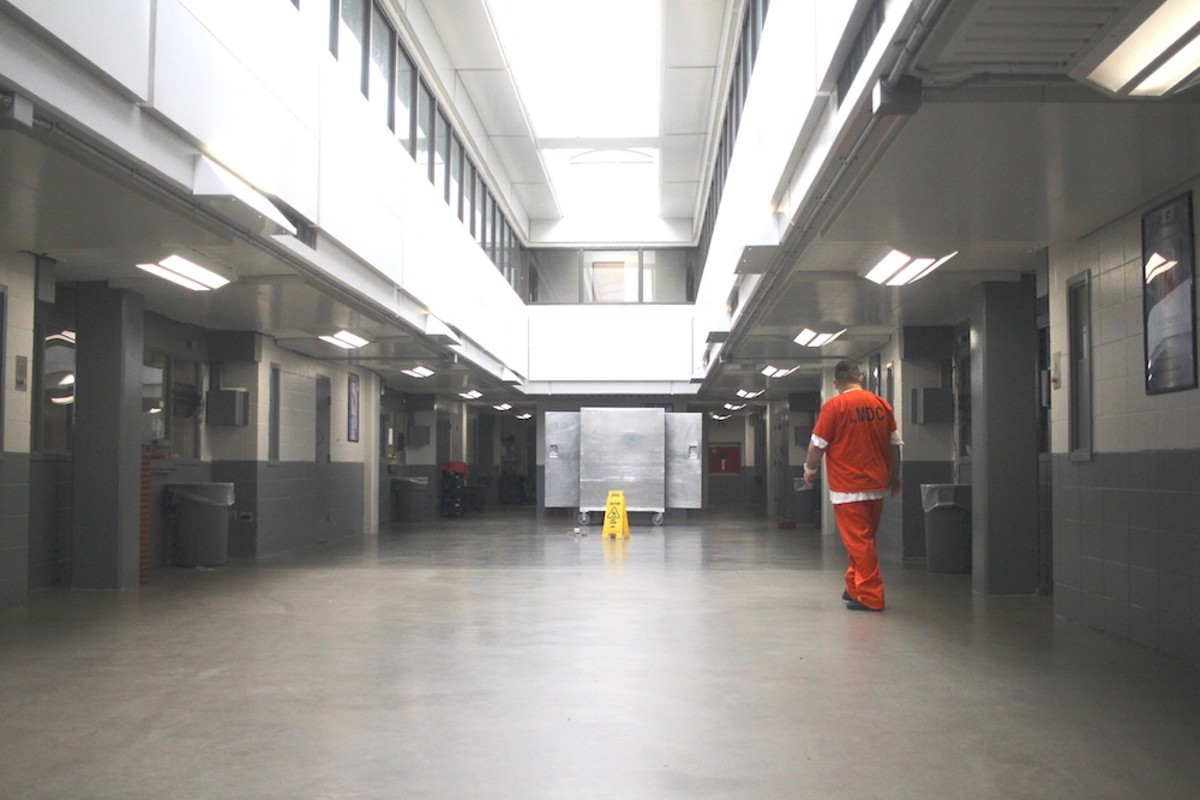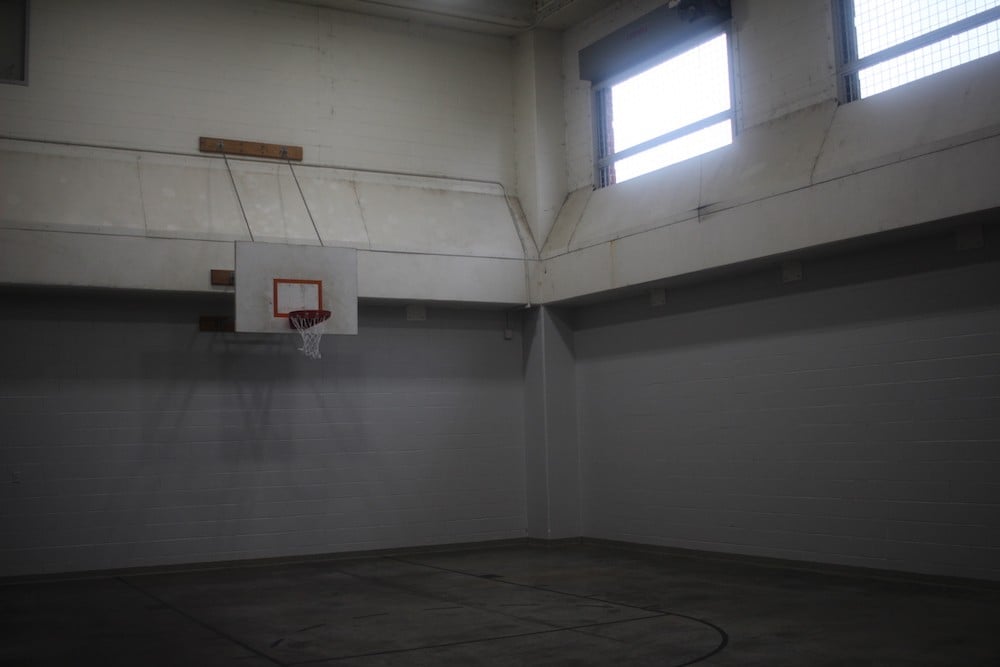On a recent Wednesday morning at downtown Louisville’s Muhammad Ali Center, people filtered past a board filled with the logos of groups that are not typically partners in a city where relations with law enforcement remain frayed after the police killing of Breonna Taylor and a surge of jail deaths: Black Lives Matter and the Louisville Metro Department of Corrections; The Bail Project and the Fraternal Order of Police; The American Civil Liberties Union and the Louisville Metro Police Department.
The logos on the board that morning represented participants in a day-long symposium hosted by the city to discuss the crisis at Louisville’s jail, which saw eight incarcerated people die in the span of less than four months between late November and March — a sharp increase from the average of three deaths per year over the previous decade and a half. With the goal of promoting change, the symposium brought together activists, harm reduction specialists, politicians, formerly-incarcerated people, attorneys, bureaucrats and plainclothes cops with guns on their hips.
For a jail whose previous administration earlier this year pushed back against notions that some of those deaths could have been prevented and that conditions were unsafe, the event — sponsored by the jail — was striking.
In opening remarks, Dr. Mariya Leyderman, a psychologist recently hired by the jail who organized the conference, talked about the need to heal and change an incarceration system that is inherently harmful and traumatic.
Louisville Mayor Greg Fischer said the United States had lost its way when it comes to incarceration, which, in this country, is not designed to help people.
New jail director Jerry Collins spoke about the need for “systemic” and “dynamic” change at Metro Corrections.
For the keynote address, a prison abolitionist spoke of the failures of incarceration and how such systems were designed not for safety, but to control certain segments of the population.
Since a change in leadership in April, the jail had been saying it had transformed for the better, committing to wide-reaching safety improvements in the facility while also embracing openness instead of isolation when critical incidents occur. At the Aug. 10 symposium, the jail, which like the city’s police department has served as a lightning rod for anger, was inviting critics into dialogue.
“I’m welcoming everybody in. Let’s take a look at our challenges. You know, if we can contribute and do something right now, that’s what we’re going to do,” said Collins, the new jail director, in an interview a week after the symposium. “This is the community’s jail — they need to be able to contribute to that.”
At the symposium, tiny clay pots, bags of soil and seeds were waiting for attendees when they arrived — an invitation for them to form a commitment and “plant the seeds” for change, organizers said. At the end of the day, participants were invited to use markers to write words on the pots as reminders of what they want to see in the jail.
Collins wrote two things on his: Change and programming.
Shameka Parrish-Wright, runner-up in May’s Democratic mayoral primary and the director of VOCAL-KY, an organization that focuses on incarceration, homelessness and harm reduction, had mixed feelings after attending the symposium.
On one hand, she felt the jail was signaling it would be more inclusive and attentive to the community. But on the other, she did not see concrete solutions offered and is hesitant about accepting promises of sweeping change in Louisville.
“We do a good job in our city of talking and making it look like it’s good and making it look good on paper, but what plays out is something completely different,” she said.
‘PARADIGM SHIFT’
To the new jail director, the symposium — which was held four blocks north of the jail — was emblematic of a changing culture at LMDC and a new way of doing things. Collins gives a lot of credit for that change to Leyderman, the jail psychologist he hired, who he said was one on the other end of one of the first phone calls he made when he took over as director in April.“One of the things I’ve really wanted to do, and we’ve talked about for eight years, is really do a paradigm shift on officer and inmate wellness,” said Collins.
Leyderman, who studied in Israel and later at Louisville’s Spalding University, first met Collins after she “showed up at the jail as an eager grad student” full of ideas on how to transform incarceration. Collins was at the jail’s training academy at the time, and, with Leyderman volunteering, the two started conducting trainings on humane and compassionate care in a jail setting.
“That was this huge shift of what traditional correctional work was around,” she said.
During late-night conversations, the 32-year-old psychologist and Collins, 17 years her senior, would talk about the need to “change the world” and transform corrections.
“The system can be really frustrating,” said Leyderman. “A lot of my clinical work was often dealing with the symptoms and the aftermath and the challenges that arise from being in custody rather than being in a position where I could actually work on a greater scale to leverage more of that systemic change. Maybe instead of bandaging a lot of these mental health problems that come up because of systemic issues, I can now work towards identifying and helping improve that system on the front end.”
Collins, who spent 21 years at LMDC, had already left the jail for a job with the Clark County Jail across the Ohio River in Indiana by the time the rush of deaths occurred.
When he returned to Louisville as the jail’s director in April, after more than six months away, he said he saw a department whose morale had deteriorated away.
“When I talk about the morale being down and the way folks are carrying themselves — that directly affects how they do their job,” he said. “Which also goes hand in hand in how we go about recruiting.”
The union that represents LMDC officers has previously said staffing shortages at the facility created dangerous conditions within the jail, with too few officers to adequately monitor the number of people held at the facility.
Collins says LMDC is currently about 95 officers short, but he believes that thousands of dollars being offered in new hire incentives, plus a lateral transfer program will help address that gap quickly.
While saying he was unable to discuss the details of individual jail deaths due to ongoing litigation, Collins said some of the deaths were preventable and that mistakes were made.
“There were several suicides. A number of them are unfortunate, because, a lot of times, especially on the suicide side of the house, [they] can be prevented,” he said. “I knew the challenges. But one of the advantages was I knew the human capital we had here and I knew some of the changes that we could do to circumvent some of those things.”
Since Collins took over on April 1, the jail has seen two in-custody deaths: A drug overdose in July and a suicide in August.
Speaking to LEO in February after six inmates had died within a span of 69 days, then-jail spokesperson Steve Durham downplayed notions that conditions in the facility were dangerous or that in-custody deaths could be prevented.
“People die in the emergency room waiting for care. They die on the tennis court. They die in the arms of their loved ones. And I wish we could do something to prevent people from dying in Metro Corrections — we can’t, we can’t always do that,” he said when asked about what changes could be made to prevent deaths.
In February, Fischer, Louisville’s mayor, said he had hired an investigator to conduct an independent review of jail deaths. The mayor’s office did not respond to multiple inquiries about the status of the investigation; Collins told LEO he believed the review was wrapping up soon.
POLICY CHANGES, IMPROVEMENTS UNDERWAY
While some of the changes the jail is showing off involve tone, mindset and openness, others are more concrete safety improvements and policy changes aimed at combating in-custody deaths.In late July, LEO Weekly was escorted through LMDC to see some of the changes.
The changes are largely aimed at drugs and suicides, which combined have represented eight of the ten in-custody deaths in the past year, according to city officials.
In an effort to prevent contraband entering the facility, the jail has installed two new body scanners — one where people are booked into jail and another where incarcerated people return to the jail from court at the Hall of Justice, which is connected to LMDC.
During LEO’s tour, the Clearpass x-ray scanner in the intake area appeared to provide a much sharper image than the kinds of full body scanners people might be familiar with from airports. Scans shown to LEO were so clear you could see bones, lungs, medical implants and buttons on pants. The old scanner, LMPD personnel told LEO, provided far less clarity and could be thrown off by any sort of movement.
While the jail says the introduction of the scanner has helped them intercept more drugs, LMDC spokesperson Darrell Goodlett, who accompanied LEO through the jail, said it’s still only a tool.
“Even with something like this, the majority of the contraband that we find is just found because an officer did a good search,” he said.
In what they say is another effort to prevent drug smuggling, the jail no longer provides most mail to inmates and instead gives them copies of the mail (though privileged mail — legal correspondence — is still provided in its original form).
Other changes involve shifting away from previous practices.
Food slots between dorms and hallways were previously unlocked, which Goodlett said allowed inmates on work details to pass drugs through the facility with ease. Now those slots are secured with padlocks except when food is being served.
Attorney booths — cramped rooms meant for meeting with legal counsel that lack a bed, toilet or running water — can now only house prisoners for a maximum of one hour and must be monitored when used as a holding cell.
Last December, Stephanie Dunbar hanged herself after being held in an attorney booth for 18 hours when no single cells were available. An internal investigation deemed her death potentially preventable, as guards did not regularly check on her. (Like changes to the way mail is handled, the attorney booth procedure was changed before Collins took over, he said).
Eight cells used to house people at high risk for suicide are being retrofitted to make them more resistant to suicide attempts, with blue plastic beds replacing metal ones that are easier to tie a noose onto.
Tables are also being removed from those cells, with Goodlett saying people would jump off of them in attempts to self-harm.
In a solitary confinement unit above the Hall of Justice, sheets of hard, durable plastic are being put over bars on the windows to protect against suicide attempts.
Officers now carry new emergency shears which can be used to cut down a person who has attempted hanging themselves. Previously, officers had to get a “knife of life” tool; Daniel Johnson, president of the corrections officers’ union, has previously said that some of those old tools were too dull to do the job.
LMDC also plans on installing cameras in every single-person cell in the facility, which the jail says will give officers the ability to see emergencies when they occur and respond quicker. However, the installation of cameras has yet to begin and will be a major project to undertake, said Goodlett, and there is no estimate on when the cameras will be installed.
Another technology update will involve installing electronic RFID tags throughout the jail that guards will have to scan to show they completed their checks instead of marking down on paper, as they currently do. In the death of Dunbar, the woman who hanged herself in an attorney booth in December, an internal breach of policy investigation found that two LMDC officers had fabricated observation sheets, writing they had completed checks on certain parts of the jail at times that they were caught on camera in different parts of the facility.
When the new system is installed, “there’s no fudging times — there’s no ifs ands or buts,” said Goodlett.
Additionally, he said, the system will streamline sharing information about inmates and their statuses, allowing officers to pull up information on mobile devices.
PARTS OF JAIL ‘LIKE HEAVEN AND HELL’
During the day-long Aug. 10 symposium, organizers hosted a Zoom call with a group of incarcerated men at LMDC who were in Chance For Change, the jail’s substance abuse recovery program.As part of a specialized program, the men are housed in a separate dormitory away from general population and have highly-structured schedules. One by one, incarcerated men in orange jumpsuits told the more than 100 people gathered at the symposium about how the program had been transformative and even lifesaving. Those who had repeatedly been behind bars were adamant that thanks to the program, their experience this time around was different.
Given the opportunity to ask a question, LEO Weekly asked about how their program’s dorm differed from general population living areas.
“It’s like heaven and hell,” said one man. He said people weren’t sleeping on floors in his program’s dorm like they often have to in other areas of the jail and that general population dorms were filthy, with guards taking away cleaning supplies they fear they will be used as weapons.
Another incarcerated man in the program echoed those sentiments.
“Some people come into the programs just to stay away from general population,” he told the symposium. “It’s kind of Armageddon in the other dorms.”
The experiences of the men matched what LEO saw during a tour of the jail in late July: On the whole, general population dorms appeared crowded and sometimes dirty and chaotic. People were often seen sleeping on the floor because not enough beds were available.
By comparison, specialized dorms like Chance for Change and another one for military veterans appeared clean, uncrowded, calm and orderly. While other dorms had TVs mounted outside their windows, the specialized dorms were allowed to have TVs mounted inside their living space on the wall. It was a striking contrast.
Those kinds of conditions in general population can spark conflict: As LEO previously reported, Dunbar, who hanged herself in an attorney booth in December, was removed from general population after a fight that resulted from a woman throwing her mattress on the floor in a dorm so crowded that at least five people were already sleeping on the floor.
Later on during the Aug. 10 symposium, Marcus Jackson, an organizing coordinator with the ACLU of Kentucky who was previously incarcerated, questioned why the conditions in the Chance For Change dorm couldn’t be replicated throughout the facility.
“One thing they talked about was how nice their dorm was that they were in, right? You don’t have to worry about this, you don’t have to worry about that,” he said. “If you can do it within that institution within one of the dorms you can literally do that within every part.”
Collins, the jail director, says he wants to broaden the jail’s use of special programs and hopes to have 400 inmates — or roughly 30% of the facility’s average daily population — in a special program by the end of the year.
Doing that would mean doubling the number of specialized dorms from seven to 14.
“This is all part of making the folks that are in those programs better,” said Collins in an interview with LEO Weekly. “But it’s also part of making a safe jail. Them are the best-behaved dorms. They go by rules. They’re hitting our mission on so many points on putting people in the community better than they were.”
Collins said the specialized dorms are also a chance to provide inmates with wraparound services, connecting them to things like mental health resources and re-entry opportunities.
The jail’s spokesperson, Goodlett, echoed Collins on the effect of specialized dorms.
“We always have a ton less issues. It’s for a few reasons. One, they’re usually less crowded. Two, they’re busy,” with packed schedules in their programs, he said. “The structure brings a lot more peace. In a perfect world, every dorm would have a structure like that. But there’s no way to manage the entire population that closely, it’s almost impossible.”
The jail is currently planning on reopening its GED program for the first time since the COVID-19 pandemic; When LEO toured the facility, that dorm featured a freshly-painted mural and was being prepared to house incarcerated people.
Beyond the established programs, Collins mentioned the possibility of a program similar to others in the country where prisoners would be guided through writing memoirs about their experiences.
LMDC is also planning on a pilot program where inmates will learn digital skills necessary for life and employment upon their release on computers loaded with an offline operating system that mimics the internet.
“The idea is that by delivering content this way, and helping them gain their digital skills and mimicking what the internet can do and what computers can do, once they have been released they can become full digital citizens with access to banking, access to civic engagement, access to healthcare, access to jobs, access to education,” said Ricky Santiago, digital inclusion manager for Louisville Metro Government, during a presentation at the Aug. 10 symposium on the jail.
CALLS FOR A NEW JAIL
Jail officials warn, however, that there is only so far changes to the current facility can go.LMDC was never designed as a jail; In its previous life, it was the headquarters for Metropolitan Sewer District. After MSD left the building for more space in 1995 after occupying 400 S. 6th Street for 27 years, the structure was gutted and retrofitted to turn it into a jail.
“It was never meant to be a jail,” said Goodlett, the jail spokesperson. “[It’s] a very antiquated kind of design. All of your more modern jails have more direct supervision design.”
Rather than large, open areas ringed by cells — a hallmark of modern jail and prison design— LMDC feels maze-like, with single person cells and dormitories branching off of narrow hallways.
Walking inside the jail’s hallways, officers often have limited sight lines into living quarters. LEO saw one group of individual cells clustered around a common area that was completely cut off from a hallway, placing multiple doors between inmates and the nearest officer.
Collins, the jail director, says while his officers are doing the best they can, they are limited and that ultimately, the city needs a new jail.
“To answer your question bluntly: Yes, we do need a new jail,” he said. “And it needs to be different. And what I’m talking about — folks when they’re talking about ‘build it and they will come’ — I’m not talking about capacity, I’m talking about our ability to do our job in the best way to help the folks that work here and the folks that transition through here as residents.”
He added: “We’re having to jump through hoops right now to try do the best we can with what we’ve got. But that’s where we’re living at.”
Parrish-Wright, the VOCAL-KY director who has been closely involved in pushing efforts for jail reform in the city, said she is hopeful about the direction of the jail’s new leadership. However, she does not feel that the creation of a new jail will address the problems leading to deaths at LMDC and fears a new facility will only ramp up pressure to fill the space with more incarcerated people.
“I don’t think a new building is going to resolve that if you don’t build in better policies and procedures on how we handle people when we have control of their bodies,” she said.
She added: “Stephanie Dunbar could still be with us today. All of them could be with us today. Every one of them deaths is a policy failure.”
CITY AT LARGE
Thomas Bradshaw, the most recent person to die in LMDC custody, was arrested for the last time on Aug. 16 at the Circle K next to the I-264 ramp on South 3rd Street. According to an arrest citation, an LMPD officer observed him panhandling “directly in front of a LMPD No Trespassing Sign.”Ten days later, LMDC said the 43-year-old man had died at University of Louisville Hospital after attempting suicide by hanging at the jail days earlier.
After all of the calls for reducing the jail’s population, not criminalizing homelessness and not punishing low-level drug crimes with incarceration, the police still arrest people for misdemeanors and judges still saddle some of those people with high bonds that they cannot afford, forcing them into a jail that has seen ten deaths in the last nine months.
Bradshaw’s last arrest citation, like a few others, listed an address. But many citations he’d received in recent years were labeled CAL or “city at large” — LMPD officer shorthand for homeless.
“I think this recent death shows that there’s still a lot of work to be done, not just within the jail, but also how we handle individuals like Mr. Bradshaw and the discretion officers have to arrest or not,” said Kungu Njuguna, a policy strategist with the ACLU of Kentucky. “We need alternatives to jail. That’s where we need to be investing our resources.”
Bradshaw had been held on a $1,000 bond for the Aug. 16 criminal trespassing charge and a slew of outstanding failure to appear warrants for a number of misdemeanors. Despite a public defender’s arguments during an arraignment the next day that Bradshaw did not have a home to go to, the judge insisted that if he posted bond, he be placed on the city’s home incarceration program.
According to court records, the previous charges were mostly for allegedly shoplifting goods from local pharmacies and convenience stores. According to LMPD, sometimes he took candy, other times cologne or batteries. One officer wrote that he was a “serial shoplifter.” When caught, police said he’d quickly admit to the thefts. Oftentimes, he was let go with a citation and a court date.
In one citation that ultimately led to a bench warrant, a University of Louisville Police Department officer tracked down Bradshaw after he allegedly shoplifted items from a Speedway gas station store in the middle of the night in November 2019. The officer provided an inventory of the items taken:
2 sandwiches - $3.29 x2 Flashlight $8.99 Hat $14.99 Gloves $8.99
Keep Louisville interesting and support LEO Weekly by subscribing to our newsletter here. In return, you’ll receive news with an edge and the latest on where to eat, drink and hang out in Derby City.
Follow us on Facebook, Twitter and Instagram.










